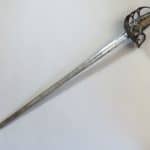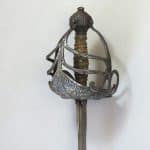
An English Civil War Period Mortuary Sword Circa 1640-1660
To enquire about this itemplease click here
Price: £3,850
Ref: 42052274
Item Description
An attractive English “Mortuary” sword with a finely chiselled hilt dating to the middle part of the 17th century and the English Civil War and Protectorate periods.
The hilt is of typical form consisting of a broad boat-shaped guard plate from which three curved primary guard bars, the knuckle bow and two side guard bars, extend upwards ending in flattened angled terminals screwed through eyelets into the pommel with circular headed screws. Two downward facing secondary guard bars emanate from each side of the knuckle bow near its middle and join the base of each side guard bar to strengthen the structure. Two further supporting guard bars emanate from the other face of the side guard bars and scroll downwards to join the guard plate at the wristguard
The guard plate including its upturned prow is covered with chiselled decoration to the outside consisting of finely executed foliate patterns. The secondary guard bars to the front are chiselled with simple linear features to the middles. The merlons at the base of the side guard bars are also chiselled with foliate designs. The pommel is globular in shape and has an integral button on top and a pronounced flared neck beneath. It is also chiselled with fern-like lines.
The baluster shaped wooden grip is wrapped with leather, bound with twisted brass wire and has brass woven “Turks’ Heads mounted top and bottom. The grip base sits on an iron flanged plug mounted onto the inside of
the guard plate from which two langets extend through the tang aperture to flank the blade either side for a short distance from the hilt.
The double-edged blade is of lenticular section and has a pronounced ricasso extending for 2.25 inches (just under 6 cm) from the hilt with two deep fullers applied just inside each blunt edge. A shallow fuller runs from the end of the ricasso along the middle of the blade for 5.5 inches (14 cm).
Inside the fuller the mark “ANDREA FERARA” is finely incised on both sides of the blade separated by a design of counter facing crescents and dots and flanked by cross shapes formed from four pointed star shaped dots. An incised running wolf mark is present just beyond the fuller terminal on each side. The marks most likely indicate that the blade was made in Solingen in Germany which was an important manufacturer of blades for use in the English Civil War and huge numbers were imported into Britain during this period for use by both Royalist and Parliamentarian sides.
The blade is 32 inches long (81.5 cm) and overall the sword is 39 inches (99 cm) long.
For further examples of Mortuary swords see Stuart C Mowbray’s “British Military Swords”, Mowbray Publishing, 2013, in the section dedicated to Mortuary Swords, pages 178 to 225. And see Cyril Mazansky, British Basket Hilted Swords, Boydell Press 2005, Chapter 11, pages 233 to 280.
The sword is in fair condition overall with some old pitting to the hilt. The hilt is firm and in good shape.























